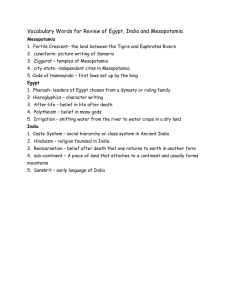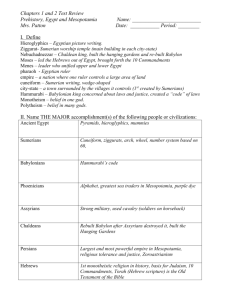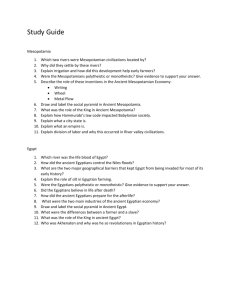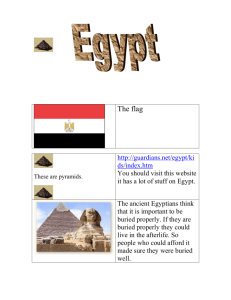Ancient Egypt and Mesopotamia
advertisement
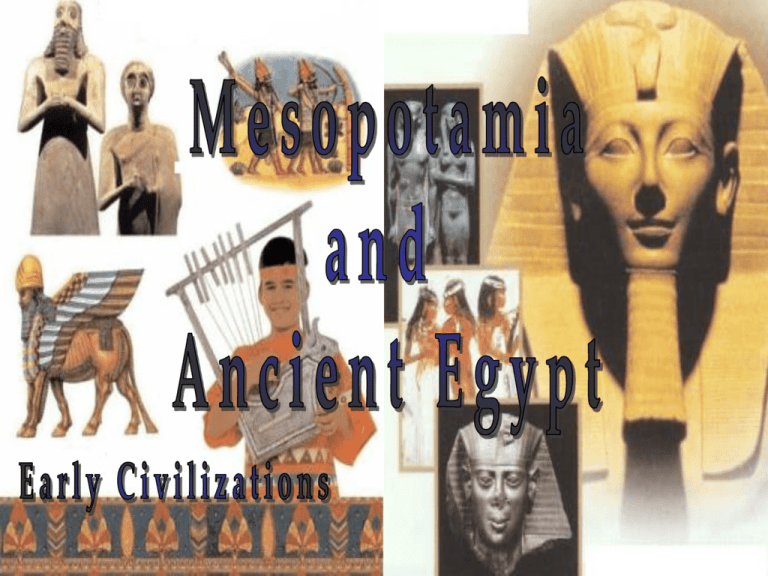
Mesopotamia One of the first civilizations, a culturally developed or advanced state of human society with a political, economic and social system and a developed method of writing, that grew in the fertile crescent of land between the Tigris and Euphrates Rivers. The site was one of the first permanent human settlements. The area where Mesopotamia was located is now present day Syria and Iraq. Mesopotamia Circa, about the time of, 4500 B.C. wandering people settled in large numbers in the area and began farming. They created a 12 month calendar based on the phases of the moon and the plow, an instrument used for farming. Mesopotamia Some of the villages and towns became city-states, which were made up of the city and farmland surrounding it. The city-state was a theocracy, a government ruled by an individual who was both the king and religious leader. Mesopotamia The earliest of the city-states rose in an area called Sumer. The Sumerians created a system of writing known as cuneiform. Circa 2300 B.C. the warlike kingdom of Akkad conquered Sumer and several other citystates to create the first empire, a group of states or territory under one ruler with sole authority. Mesopotamia King of Babylon, King Hammurabi created a code called Hammurabi’s Code, it contained the first written law, an attempt to bring some justice and fairness to the idea of law. Mesopotamia The people in Mesopotamia were polytheistic, the worship of or belief in more than one god , like the sun, moon, and the air. Pyramid shaped temples were built to house the statues of their gods. Apkallu fish Usmu (Isimud) Adad (Ishkur) Gula Lama Ishtar (Inanna) Mesopotamia They were great traders and left many gifts to society such as the potter’s wheel, carts, chariots, cuneiform writing, and musical notation. Mesopotamians also left other gifts like instruments to measure time, the 60 minute hour, the 60 second minute, which we still use today, and the calendar. Astronomy, the study of stars and the night sky. Ancient Egypt Like Mesopotamia, Egyptian civilization, grew out of a river valley, the Nile River, the longest river in the world. Egypt expanded as far as Mesopotamia in the north and southward to present day Sudan. Ancient Egypt The two kingdoms of Upper Egypt and Lower Egypt were united circa 3100 B.C. under a pharaoh, a great ruler. Ancient Egypt Egyptians had a polytheistic religion, meaning they worshipped many gods. Ancient Egypt Egyptians believed in life after death. They embalmed their dead to preserve the body for their next life. They would preserve the body immediately after death as a mummy. Ancient Egypt The Egyptians would bury their dead in tombs. The largest tombs belonged to the pharaohs and were called pyramids. http://www.bbc.co.uk/history/ancient/egyptians/launch_gms_mummy_maker.shtml Ancient Egypt Hieroglyphics is a form of picture writing with about 800 signs. In 1820, the Rosetta Stone provided the key that cracked the code for hieroglyphics. Ancient Egypt The Egyptians were famous for trading goods such as hard woods, incense, and ivory. Their greatest gift were the pyramids. Many have wondered how they were built, but today archaeologists, people who study human cultures, believe it took about 20,000 workers and about 20 years to build a pyramid.
